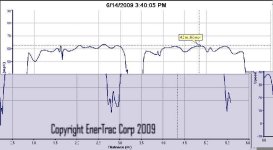liveforphysics
100 TW
swbluto said:liveforphysics said:The winner, team Agni, posted a time that beat the 50cc record for the track set in 1966.
"Barber led the TTX GP from the early stages and crossed the line at the end of the one lap race with a time of 25m 53.5s, 87.43mph, just inside the 50cc TT lap record of 86.49mph, set by Ralph Bryans in 1966.
Barber, riding for Team Agni in the Pro class, finished a whopping 3m 11.43s ahead of second place Thomas Schoenfelder on the XXL Racing Team entry. Schoenfelder clocked the fast time through the Sulby speed trap of 106.5mph, the only rider to exceed 100mph.
Barber said: “I’m really pleased for Cedric (Lynch – the creator of the winning machine who has been building electric bikes for competition since 1981). He really wanted to beat that 50cc record and we’ve done it."
Please tell me, what's so great about that? Aren't these electric bikes supposed to be much faster than a 50cc equivalent (50cc's only get, what, 15 hp at max?)?
It could be up to 15bhp if it were on Methanol, but this pre-dates power-valves found in modern 2-strokes, so it would be a very very narrow little peaky powerband if it had 15hp. With the right gearing selection, that does work fine though.
How was it so fast on such little power you are asking? Because those bikes were basically bicycles fitted with an engine, which let them all be under 100lbs, even with garbage 1966 metals and crap drum brakes. You get anything under 100lbs, and you give it 15bhp, and it goes pretty damn well. My E-bike is a perfect example of that.
Here is a picture of a 1966 50cc GP racing bike to give you an idea of how bicycle-ish they were. The men that raced on crap rubber with crap safety and crap metallurgy were all heros.
But, now I'm getting this thread way off topic... Sorry!



